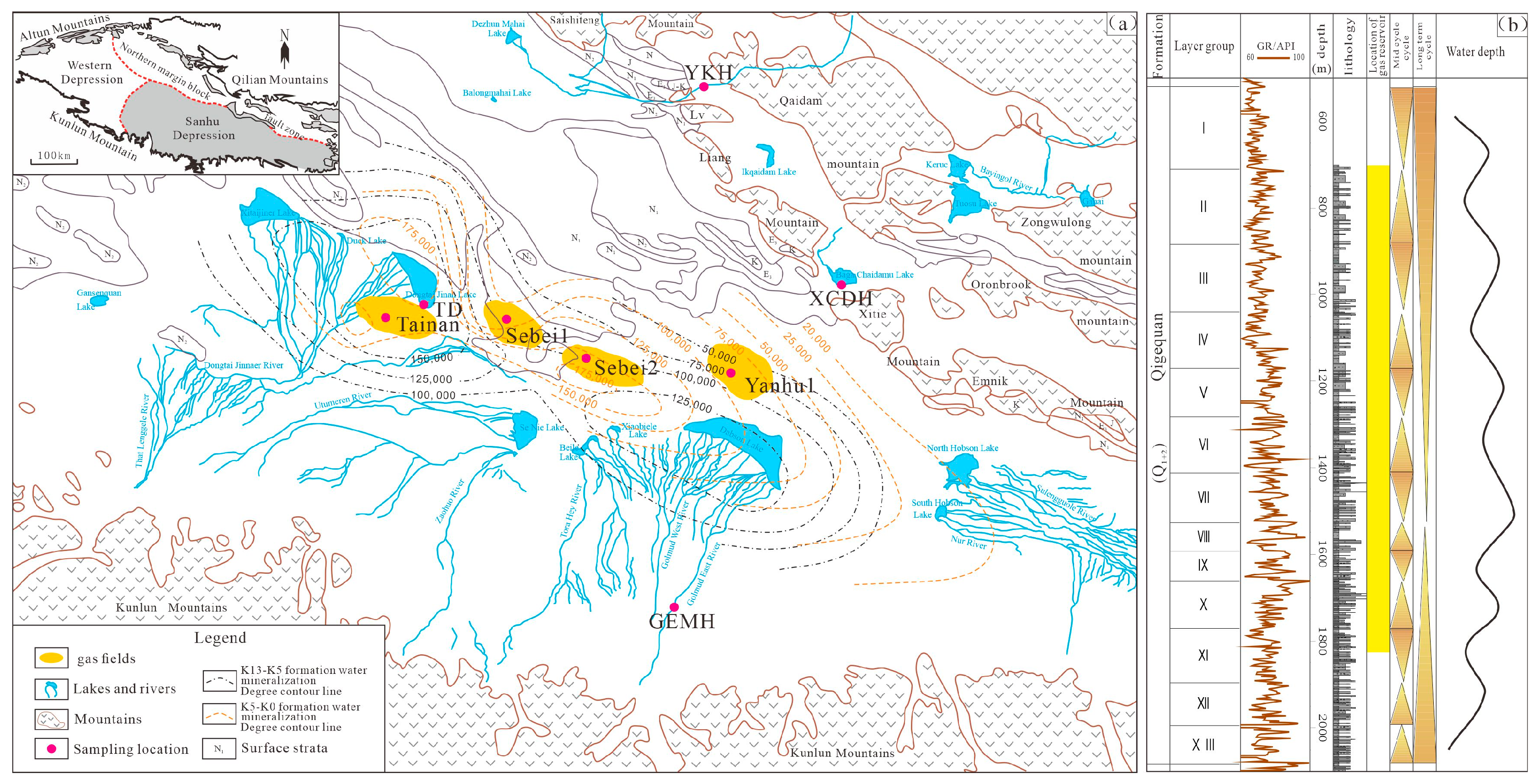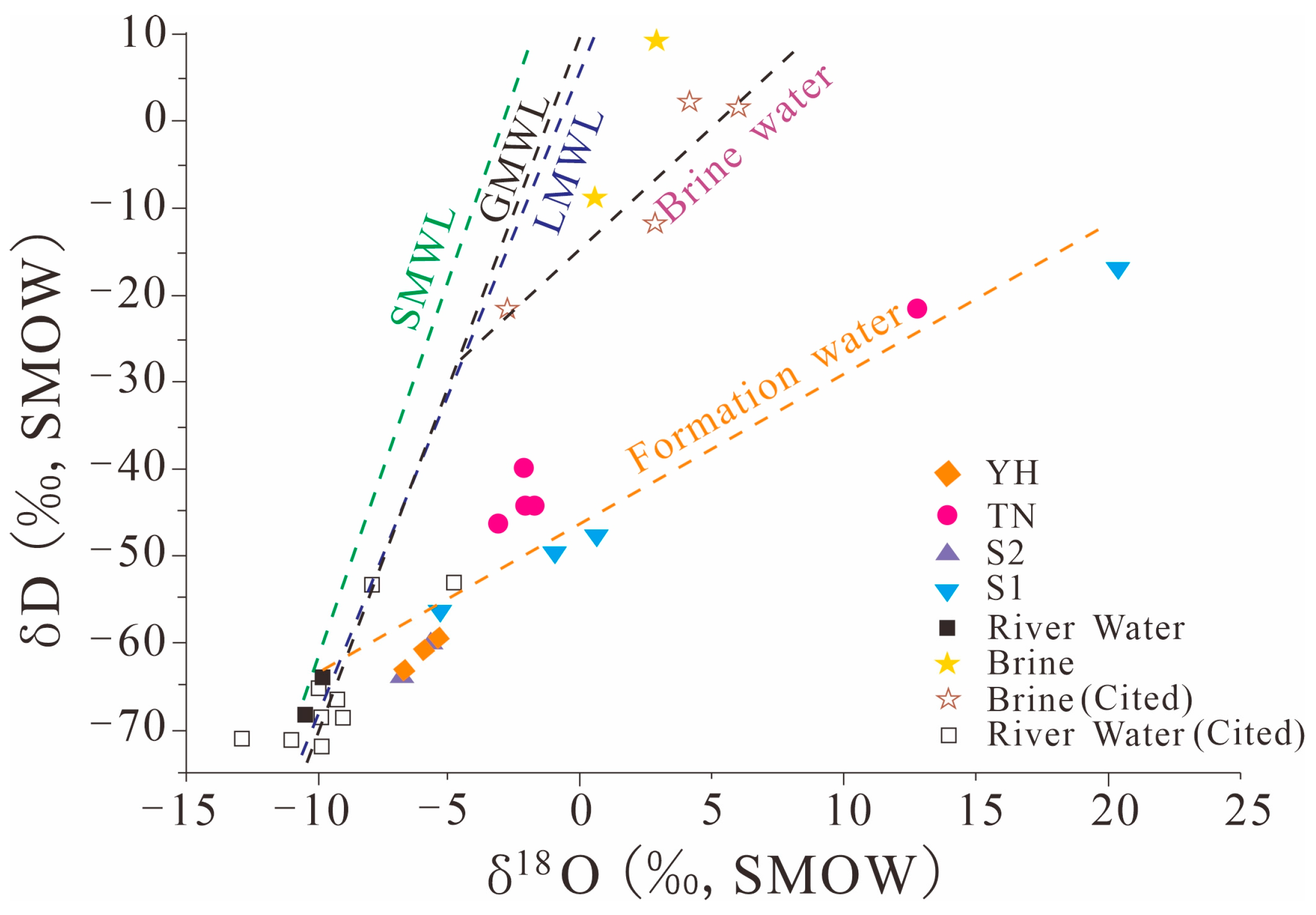The Influence of Groundwater Migration on Organic Matter Degradation and Biological Gas Production in the Central Depression of Qaidam Basin, China
Abstract
:1. Introduction
2. Study Area and Methods
2.1. Study Area
2.2. Sampling
2.3. Laboratory Analysis
2.4. Data Processing
3. Results
3.1. Hydrochemical Parameters
3.2. Stable Isotopes Distribution of Hydrogen and Oxygen
3.3. Organic Carbon Content Distribution and the CDOM Spectrum Characteristics
4. Discussion
4.1. Groundwater Migration and Hydrochemical Evolution Characteristics in the Central Depression Area of Qaidam Basin
4.2. Organic Matter Degradation Caused by Groundwater Migration in the Central Depression Area of Qaidam Basin
5. Conclusions
Author Contributions
Funding
Data Availability Statement
Acknowledgments
Conflicts of Interest
References
- Bricaud, A.; Morel, A.; Prieur, L. Absorption by dissolved organic matter of the sea (yellow substance) in the UV and visible domains. Limnol. Oceanogr. 1981, 26, 43–53. [Google Scholar] [CrossRef]
- Zhao, D.; Wang, G.; Liao, F.; Yang, N.; Jiang, W.; Guo, L.; Liu, C.; Shi, Z. Groundwater-surface water interactions derived by hydrochemical and isotopic (222Rn, deuterium, oxygen-18) tracers in the Nomhon area, Qaidam Basin, NW China. J. Hydro. 2018, 565, 650–661. [Google Scholar] [CrossRef]
- Gao, L.; Brassell, S.C.; Mastalerz, M.; Schimmelmann, A. Microbial degradation of sedimentary organic matter associated with shale gas and coalbed methane in eastern Illinois Basin (Indiana), USA. Int. J. Coal Geol. 2013, 107, 152–164. [Google Scholar] [CrossRef]
- Guo, P. Saline Environment Evolution of the Cenozoic Qaidam Palaeolake and the Characterization of Its Hydrocarbon Source Rocks. Ph.D. Thesis, Northwest University, Xi’an, China, 2018. [Google Scholar]
- Huguet, A.; Vacher, L.; Relexans, S.; Saubusse, S.; Froidefond, J.M.; Parlanti, E. Properties of fluorescent dissolved organic matter in the Gironde Estuary. Org. Geochem. 2009, 40, 706–719. [Google Scholar] [CrossRef]
- Yang, H.; Wei, J.; Ren, Q. Interaction between surface water and groundwater and hydrochemical characteristics in the typical watersheds of the Qaidam Basin. Ganhanqu Yanjiu. 2022, 39, 1543–1554. [Google Scholar]
- Li, J. Enrichment and Metallogenic Mechanism of the Brine-Type K, B, Li Resources in the Qaidam Basin, W. China. Ph.D. Thesis, University of Science and Technology of China, Hefei, China, 2022. [Google Scholar]
- Shan, J.; Ju, J.; Zhang, W.; Han, H.; Zhou, T.; Wang, Y.; Yang, S.; Cao, Y. Hydrocarbon accumulation patterns of salt crust covered biogenic gas reservoirs in the Sanhu Depression, Qaidam Basin. Nat. Gas. Ind. B 2020, 7, 120–126. [Google Scholar] [CrossRef]
- Zheng, J.F.; Shen, A.J.; Liu, Y.F.; Chen, Y.Q. Genesis and Distribution of the Cambro-Ordovician Dolomite in Tarim Basin. Xinjiang Pet. Geo. 2011, 32, 598–600. [Google Scholar]
- Li, B.; Wang, M.; Ran, Q. Effect of the salinity of formation water on biogas migration, accumulation and reservoir formation. Nat. Gas Ind. 2003, 23, 16–20. [Google Scholar]
- Twardowski, M.S.; Boss, E.; Sullivan, J.M.; Donaghay, P.L. Modeling the spectral shape of absorption by chromophoric dissolved organic matter. Mar. Chem. 2004, 89, 69–88. [Google Scholar] [CrossRef]
- Yang, M. Paleoenvironmental Evolution in the Neogene-Quaternary Period of the Sanhu Depression. Ph.D. Thesis, Lanzhou University, Lanzhou, China, 2018. [Google Scholar]
- Yin, M.; Huang, H. Quaternary exhumation history of the NE Tibetan Plateau revealed by peculiar distributions of polycyclic aromatic hydrocarbons in core extracts from the Sanhu depression, eastern Qaidam basin. J. Quat. Sci. 2020, 35, 869–880. [Google Scholar] [CrossRef]
- Yang, N. Characteristics of Groundwater Stable Isotopic Compositions in Eastern Qaidam Basin: Implications for Moisture Sources and Climate Change. Ph.D. Thesis, China University of Geosciences (Beijing), Beijing, China, 2021. [Google Scholar]
- Yang, N.; Zhou, P.; Wang, G.; Zhang, B.; Shi, Z.; Liao, F.; Li, B.; Chen, X.; Guo, L.; Dang, X.; et al. Hydrochemical and isotopic interpretation of interactions between surface water and groundwater in Delingha, Northwest China. J. Hydrol. 2021, 598, 126243. [Google Scholar] [CrossRef]
- He, P.J.; Xue, J.F.; Shao, L.M.; Li, G.J.; Lee, D.J. Dissolved organic matter (DOM) in recycled leachate of bioreactor landfill. Water Res. 2006, 40, 1465–1473. [Google Scholar] [CrossRef] [PubMed]
- Lin, P. Influence Factors and Formation of Quaternary Biogenic Gas of Nuobei Area in Sanhu Depression, Qaidam Basin. Master’s Thesis, Nanjing University, Nanjing, China, 2018. [Google Scholar]
- Albrecht, R.; Joffre, R.; Gros, R.; Le Petit, J.; Terrom, G.; Périssol, C. Efficiency of near-infrared reflectance spectroscopy to assess and predict the stage of transformation of organic matter in the composting process. Bioresour. Technol. 2008, 99, 448–455. [Google Scholar] [CrossRef] [PubMed]
- Cheng, Y.Y.; Wang, S.L.; HU, S.B.; Zhou, C.Y.; Shi, Z.; Li, Q.; Huang, X.P. The Fluorescence characteristics of dissolved organic matter (DOM)in the Seagrass ecosystem from Hainan by Fluorescence Excitation-Emission Matric Spectruscopy. Spectrosc. Spectr. Anal. 2015, 35, 141–145. [Google Scholar]
- Shuai, Y.; Zhang, S.; Chen, J.; Su, A. Source of nutrient substrates for microbes in deep biosphere and characteristics of biogenic gas source rock. Sci. China Earth Sci. 2010, 53, 1163–1168. [Google Scholar] [CrossRef]
- Shuai, Y.; Zhang, S.; Zhao, W.; Su, A.; Wang, H. Longitudinal distributions of two formation pathways of biogenic gases in continental deposits: A case study from Sebei 1 gas field in the Qaidam Basin, western China. Sci. China Ser. D-Earth Sci. 2007, 50, 221–227. [Google Scholar] [CrossRef]
- Xiao, Y. Groundwater Circulation Patterns and Its Change Trend in Southern Qaidam Basin, Northwest China. Ph.D. Thesis, China University of Geosciences (Beijing), Beijing, China, 2018. [Google Scholar]
- Xiao, Y.; Shao, J.; Frape, S.K.; Cui, Y.; Dang, X.; Wang, S.; Ji, Y. Groundwater origin, flow regime and geochemical evolution in arid endorheic watersheds: A case study from the Qaidam Basin, northwest China. Hydro. Earth Syst. Sci. 2018, 22, 4381–4400. [Google Scholar] [CrossRef]
- Zhang, Y.; Miao, M.; Xu, J.; Jia, Z.; Li, Q.; Lin, Y.; Wang, M.; Wang, R. Distribution of Biogenic Gas Reservoirs and Optimization of Favorable Zones in the Sanhu Area, Qaidam Basin, China. Sustainability 2023, 15, 9920. [Google Scholar] [CrossRef]
- Ju, Y.P.; Lv, R.S.; Yang, J. Three-dimensional excitation emission matrix fluorescence spectroscopic characterization of dissolved organic matter in coal mine water. Meitan Xuebao 2012, 37, 1396–1400. [Google Scholar]
- Shao, Z.; He, S.; Hou, L.; Wang, Y.; Tian, C.; Liu, X.; Zhou, Y.; Hao, M.; Lin, C. Dynamic Accumulation of the Quaternary Shale Biogas in Sanhu Area of the Qaidam Basin, China. Energies 2022, 15, 4593. [Google Scholar] [CrossRef]




| Definition | Description | |
|---|---|---|
| HIX | At excitation wavelength 254 nm, HIX = | An indicator of humus content or degree of humification in dissolved organic matter [18] |
| E253/E203 | Abs 253 nm/Abs 203 nm 1 | The characteristics of functional groups on benzene ring structure in dissolved organic matter [19] |
| SUVA254 | Abs 254 nm/CDOC 2 | Aromaticity index in dissolved organic matter [19] |
| No | Type | Depth | Ca | K | Mg | Na | Cl− | SO42− | NO3− | HCO3− | TDS | δ18O | δD |
|---|---|---|---|---|---|---|---|---|---|---|---|---|---|
| (m) | g/L | g/L | g/L | g/L | g/L | g/L | g/L | mmol/L | g/L | ‰ | ‰ | ||
| TD | Brine | 0 | 0.55 | 0.45 | 0.70 | 16.0 | 26.9 | 2.86 | 1.62 | 2.1 | 54.5 | 0.51 | −8.69 |
| XCDH | Brine | 0 | 0.14 | 0.10 | 0.07 | 4.5 | 5.9 | 2.09 | 0.02 | 1.9 | 14.6 | 2.88 | 9.66 |
| GEMH | River | 0 | 0.07 | 0.02 | 0.02 | 0.1 | 0.1 | 0.10 | 0.02 | 3.8 | 1.8 | −9.73 | −64.14 |
| YKH | River | 0 | 0.10 | 0.02 | 0.01 | 0.1 | 0.2 | 0.12 | 0.02 | 3.6 | 1.9 | −10.39 | −68.55 |
| YH1 | YH | 190 | 2.47 | 0.15 | 2.19 | 31.4 | 57.2 | 0.76 | 0.95 | 0.8 | 105.5 | −6.62 | −63.32 |
| YH2 | YH | 300 | 2.84 | 0.14 | 2.18 | 36.2 | 64.3 | 0.82 | 0.85 | 1.0 | 119.4 | −5.94 | −60.91 |
| YH3 | YH | 410 | 3.26 | 0.13 | 1.80 | 44.1 | 77.7 | 0.68 | 0.37 | 0.8 | 142.8 | −5.41 | −59.41 |
| S1-1 | SB | 600 | 0.90 | 0.17 | 0.89 | 32.6 | 51.3 | 0.94 | 1.09 | 2.6 | 98.7 | 20.28 | −16.83 |
| S1-2 | SB | 685 | 0.86 | 0.17 | 0.94 | 35.3 | 57.1 | 0.82 | 0.40 | 2.4 | 107.3 | / | / |
| S1-3 | SB | 980 | 1.76 | 0.24 | 0.94 | 33.7 | 55.4 | 0.38 | 0.20 | 1.8 | 103.9 | −0.98 | −49.48 |
| S1-4 | SB | 1100 | 1.57 | 0.24 | 0.83 | 37.4 | 59.5 | 0.78 | 0.69 | 2.8 | 113.5 | −5.30 | −56.44 |
| S1-5 | SB | 1425 | 1.34 | 0.24 | 0.87 | 35.1 | 61.1 | 0.77 | 0.44 | 6.8 | 111.6 | 0.62 | −47.75 |
| S2-1 | SB | 1100 | 1.58 | 0.21 | 0.91 | 35.4 | 55.7 | 0.88 | 0.27 | 4.0 | 106.8 | −5.79 | −60.09 |
| S2-2 | SB | 1160 | 1.29 | 0.19 | 0.63 | 26.9 | 44.4 | 0.93 | 1.04 | 5.6 | 84.4 | −6.78 | −64.03 |
| TN1 | TN | 990 | 2.32 | 0.40 | 1.45 | 70.0 | 108.3 | 0.51 | 0.08 | 2.4 | 206.3 | −2.14 | −39.91 |
| TN2 | TN | 1215 | 2.81 | 0.36 | 1.29 | 56.1 | 86.7 | 0.72 | 0.11 | 3.2 | 166.7 | −3.09 | −45.86 |
| TN3 | TN | 1365 | 2.93 | 0.37 | 1.23 | 54.9 | 92.3 | 1.10 | 0.28 | 2.0 | 171.4 | −3.13 | −46.42 |
| TN4 | TN | 1500 | 3.13 | 0.42 | 1.34 | 61.4 | 96.6 | 0.54 | 0.09 | 3.0 | 183.9 | 12.72 | −21.58 |
| TN5 | TN | 1535 | 3.01 | 0.39 | 1.23 | 56.4 | 86.6 | 0.59 | 0.12 | 2.4 | 167.2 | −2.09 | −44.12 |
| TN6 | TN | 1740 | 2.78 | 0.42 | 1.21 | 58.8 | 91.6 | 0.57 | 0.20 | 3.0 | 175.2 | −1.79 | −44.36 |
Disclaimer/Publisher’s Note: The statements, opinions and data contained in all publications are solely those of the individual author(s) and contributor(s) and not of MDPI and/or the editor(s). MDPI and/or the editor(s) disclaim responsibility for any injury to people or property resulting from any ideas, methods, instructions or products referred to in the content. |
© 2024 by the authors. Licensee MDPI, Basel, Switzerland. This article is an open access article distributed under the terms and conditions of the Creative Commons Attribution (CC BY) license (https://creativecommons.org/licenses/by/4.0/).
Share and Cite
Tian, J.; He, Q.; Shao, Z.; Zhou, F. The Influence of Groundwater Migration on Organic Matter Degradation and Biological Gas Production in the Central Depression of Qaidam Basin, China. Water 2024, 16, 2163. https://doi.org/10.3390/w16152163
Tian J, He Q, Shao Z, Zhou F. The Influence of Groundwater Migration on Organic Matter Degradation and Biological Gas Production in the Central Depression of Qaidam Basin, China. Water. 2024; 16(15):2163. https://doi.org/10.3390/w16152163
Chicago/Turabian StyleTian, Jixian, Qiufang He, Zeyu Shao, and Fei Zhou. 2024. "The Influence of Groundwater Migration on Organic Matter Degradation and Biological Gas Production in the Central Depression of Qaidam Basin, China" Water 16, no. 15: 2163. https://doi.org/10.3390/w16152163




